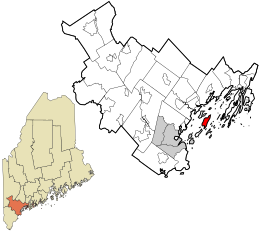Chebeague Island, Maine
| Chebeague Island, Maine | |
|---|---|
| Town | |

Chebeague Island beach
|
|
 Location in Cumberland County and the state of Maine. |
|
| Coordinates: 43°44′29″N 70°6′26″W / 43.74139°N 70.10722°W | |
| Country | United States |
| State | Maine |
| County | Cumberland |
| Incorporated | July 1, 2007 |
| Area | |
| • Total | 24.56 sq mi (63.61 km2) |
| • Land | 3.56 sq mi (9.22 km2) |
| • Water | 21.00 sq mi (54.39 km2) |
| Elevation | 62 ft (19 m) |
| Population (2010) | |
| • Total | 341 |
| • Estimate (2012) | 343 |
| • Density | 95.8/sq mi (37.0/km2) |
| Time zone | Eastern (EST) (UTC-5) |
| • Summer (DST) | EDT (UTC-4) |
| ZIP code | 04017 |
| Area code(s) | 207 |
| Website | www |
Chebeague Island is an island town in Cumberland County, Maine, United States, located in Casco Bay, 10 miles (16 km) from Portland. These islands are sometimes referred to as an older, now archaic term "The Calendar Islands" because there was once a belief that the approximate number of islands was 365. The actual number is fewer than two hundred. Great Chebeague was a part of the town of Cumberland until July 1, 2007, when it became the town of Chebeague Island. As of the 2010 census, the town had a population of 341.
Two ferry services provide transportation to the island. The Chebeague Transportation Company (CTC) makes the 15-minute run from Wharf Road on Cousins Island, which in turn is connected by bridge to Yarmouth. Casco Bay Lines also provides service on all mail-boat and other "down-bay" trips that travel beyond Long Island.
Chebeague Island is part of the Portland–South Portland–Biddeford, Maine Metropolitan Statistical Area.
According to island lore, the name "Chebeague" comes from a Native American word meaning "Island of Many Springs" (pronounced "sha-big"), as there are, indeed, many deep-running, underground fresh-water streams all over the island, in some places literally bubbling from the ground. Some Native Americans were still present after the European colonization of the area, as late as the 1870s.
The Native Americans did not dwell year-round on the island but paddled over by canoe during the summer months to fish. One can still notice areas of the island where clam shells are abundantly packed into the soil. This is mostly due to "shell piles" the Indians regularly made after their meals.
...
Wikipedia
